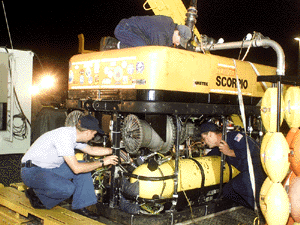
Navy Recovers "Black Boxes"
From Alaska Airlines Flight 261
Point Hueneme, Calif., Feb. 3, 2000 — Working in support of the National Transportation Safety Board, Navy personnel from the Navy's Deep Submergence Unit (DSU), based at the Naval Air Station North Island, have recovered both popularly-named "black boxes" from Alaska Airline Flight 261. The first, the cockpit voice recorder, was recovered about 4:30 p.m. (PST) Wednesday. The second, the flight data recorder, was recovered around noon (PST) today.
The crew, working aboard the motor vessel Kellie Chouest, a civilian research and salvage ship which serves as the support vessel to the Navy's Deep Submergence Unit and which is under contract to the Navy, were able to recover the recorders from the ill-fated aircraft using the Remotely Operated Vehicle (ROV) Scorpio I. The recorders were found in about 700 feet of water. The cockpit voice recorder has been transported to the NTSB headquarters in Washington, D.C., for analysis, and the flight deck recorder will be transported this afternoon. The personnel aboard Kellie Chouest, all qualified Navy submariners, had Wednesday night found the "pinger" section from the flight data recorder. The pinger was detached from the recorder making recovery efforts more difficult.
The primary operators of Scorpio I are a pilot and co-pilot, who remotely operate the ROV from a control station on the deck of Kellie Chouest. The pilot and co-pilot are supported by navigation personnel, using Global Positioning System equipment, and other personnel who operate a 5,000-foot tether or umbilical between the control station and the ROV. The primary tools for search areScorpio's sonar and several television cameras. The ROV also uses two mechanical arms called manipulators. Aboard M/V Kellie Chouest, Feb. 1, 2000 — Sailors of the Deep Submergence Unit (DSU) Unmanned Vehicles (UMV) Detachment perform routine checks on the Remotely Operated Vehicle Scorpio I prior to departing San Diego for the crash site of Alaska Airlines Flight 261. The crew recovered the ill-fated aircraft's cockpit voice recorder late Wednesday afternoon.


Aboard M/V Kellie Chouest, Feb. 2, 2000 — The first "black box" from downed Alaska Airlines Flight 261 is brought aboard the submarine supply ship MV Kellie Chouest following an 84-minute search by Scorpio, a Tethered Unmanned Work Vehicle from the Navy's Deep Submergence Unit Unmanned Vehicle Detachment. U.S. Navy photo by Photographer's Mate 1st Class Spike Call. [000202-N-5961C-005] Feb. 2, 2000. The Navy personnel aboard Kellie Chouest also have a high-resolution side scan sonar for locating and identifying objects underwater. The Navy is also operating a high-resolution side scan sonar and an ROV from a Small Waterplane Area Twin Hull (SWATH) craft from Explosive Ornance Mobile Unit Seven, out of San Diego.
The amphibious transport dock ship USS Cleveland (LPD 7), homeported at San Diego, is also on scene. The ship provides support for small boats and aircraft from Helicopter Combat Support Squadron 11 at Naval Air Station North Island. USNS Sioux (T-ATF 171), a civilian-manned ship of the Navy's Military Sealift Command, has also been searching the debris field. Sioux will be the primary salvage ship and has heavy lift equipment as well as side-scan sonar.
Two other Navy ships, USS Fife (DD 991), homeported at Everett, Wash., USS Jarrett (FFG 33), homeported at San Diego, supporting the U.S. Coast Guard, also searched the crash area for any possible survivors late Monday and early Tuesday. The two ships were then released Tuesday afternoon to resume other assigned duties. The first Navy units on the scene were a P-3C Orion maritime patrol aircraft from the Naval Air Station, Point Mugu; an HH-60 Seahawk from Helicopter Combat Support Special Squadron 5, also from Point Mugu; and an S-3B Viking patrol aircraft from the Naval Air Station, North Island, Calif. Flight 261, a Boeing MD-80, was on a flight from Puerto Vallarta, Mexico, to San Francisco when it crashed about 40 miles northwest of Los Angeles International Airport around 4:30 p.m. Jan. 31.